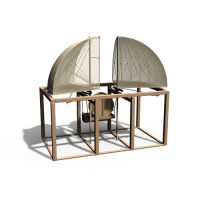Imagination and Invention Click on the thumbnails to explore the trail
Read more about this trail (expand)
The exercise of imaginative fantasy was as much an integral part of Leonardo’s mind as the discipline of scientific observation. For the artist, imagination was dependent upon an accurate understanding of observational input – a complete comprehension of the geometry of God’s design. Sensory impressions gained from observation were recombined by the artist’s ‘fantasia’ or imagination, to create new and credible forms

- Enlarge
- © Leonardo3 - www.leonardo3.net
Theatre stage set for Orpheus – Codex Arundel 224r and 231v 1508-18
The ability to make mechanical gadgets and stage machinery for theatrical spectacles was highly prized during the Renaissance. Brunelleschi, the legendary Florentine engineer much admired by Leonardo, devised festival machines or ingegni for use in churches.
Leonardo also became famous for making ingenious mechanical curiosities. For the festive celebrations for the marriage of Gian Galeazzo and Isabella of Aragon, he designed a mechanism by which ‘all the seven planets turned, and the planets were represented by men’.
A series of drawings illustrating a stage machine designed to display “Pluto’s Paradise” are the best evidence of the mechanical virtuosity that delighted Milanese audiences. The front of a mountain opens up by means of revolving sections that were probably activated by a system of ropes, weights and pulleys, to reveal Pluto with his attendant devils.
We do not know when Leonardo drew this design or why, but it was possibly made in 1509 the staging of Poliziano’s Orpheus in Milan. The title role was played by a famous musician called Atalante Migliorotti, who Leonardo knew and who may be the figure in Leonardo’s Portrait of a Musician.
In Leonardo's words
When Pluto’s paradise is opened, then there will be devils, which are in twelve pitchers acting as the mouths of hell; here will be death, the furies, Cerberus, many cherubs who weep; here fires will be made of various colours…
Leonardo designed many theatre machines. This ingenious theatre stage set was devised for the staging of the myth of Orpheus for the French government in Milan during Leonardo’s second stay in the city.
It consists of a dome-shaped stage set that represented a mountain scene. Instead of being spherical, the dome could be made in many shapes with papier mâché, and painted very realistically as a mountainscape. At a precise moment in the performance, and with considerable theatrical effect, the mountains opened with a circular movement on to a new scene, the underworld, which would also reveal Pluto accompanied by devils and furies.
The mechanism was quite simple. Initially, the protagonist was in position below the stage on a small platform that worked like a lift. Behind, operators would load a container with weights. Once loaded, the container acted as a counterweight, dropping while at the same time lifting the actor up to the stage and driving the entire mechanism that opened the domes.
Renaissance staging was basically static and dominated by urban buildings set in perspective, the so-called “perspective stage setting”. Leonardo’s innovation consisted of introducing a dynamic, changing stage and setting the representation in a naturalistic, rather than an urban, space.
- Location British Library










